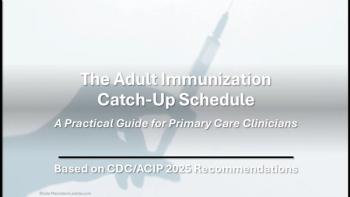
Uncomplicated UTIs in Elderly Patients:
ABSTRACT: The diagnosis of urinary tract infection (UTI) can be difficult in elderly patients, who may present with vague complaints or atypical symptoms. Office-based urine testing is less sensitive and specific in these patients because they are less likely to have pyuria and more likely to have contaminated specimens than younger adults. Antibiotics used to treat uncomplicated UTIs in the elderly include trimethoprim-sulfamethoxazole (TMP-SMX), fluoroquinolones, fosfomycin, nitrofurantoin, cephalosporins, carbenicillin, and trimethoprim. When you select an agent, consider the side-effect profile, cost, bacterial resistance, likelihood of compliance, and the patient's renal function. The optimal duration of treatment of uncomplicated UTIs in elderly women is still a matter of debate. Options for prophylaxis in patients who have recurrent uncomplicated UTIs include estrogen replacement therapy (vaginal or oral) and nitrofurantoin.
Urinary tract infections (UTIs) are common in community-dwelling elderly persons; they account for 25% of infections in this population.1 Moreover, progression to a systemic infection can lead to significant morbidity and mortality.
UTIs in the elderly differ from those in younger patients. To manage them effectively, different strategies are required.
In this article, we provide an evidence-based approach to the treatment of uncomplicated UTIs in the elderly. We also highlight "red flags" that may indicate the need for admission and/or consultation with a specialist. Because UTIs in elderly men are considered complicated UTIs, we discuss these only briefly; our focus here is primarily on UTIs in elderly women.
BACKGROUND
Definitions. UTI in women is defined by the presence of at least 100,000 colony-forming units (CFU)/ mL in a pure culture of voided clean-catch urine. In men, the presence of just 1000 CFU/mL indicates UTI. Because some laboratories do not routinely identify and determine the sensitivity of organisms in specimens with fewer than 10,000 CFU/mL, be sure to ask your laboratory to perform these tests on specimens from men that contain 1000 CFU/mL or more.
Asymptomatic bacteriuria is the presence of bacteria in the urine of patients who do not have dysuria, urinary frequency, urgency, fever, flank pain, or other symptoms related to irritation of the urethra, bladder, or kidney (Box).
UTIs in women are considered complicated when they:
•Are secondary to structural abnormalities, catheters, stones, or urinary retention.
•Lead to abscess formation or urosepsis.
•Are caused by hematogenous spread.
All UTIs in men are considered complicated.
Recurrent UTIs are culture-confirmed UTIs with a frequency of more than 3 in 1 year or more than 2 in 6 months. Recurrent UTIs can be further divided into relapse UTIs and reinfection UTIs:
•A relapse UTI occurs within 2 weeks of treatment of an earlier UTI and is caused by the same pathogen that caused the first infection.
•A reinfection UTI occurs more than 4 weeks after an earlier UTI and usually involves a different pathogen.2
Diagnosis. The diagnosis of UTI can be difficult in elderly patients, who may present with vague complaints. When comorbidities and their treatment cloud the clinical picture, the patient's symptoms may be atypical.
Office-based urine testing is less sensitive and specific in the elderly because they have less pyuria and a high rate of contaminated specimens.3 Another confounding factor is the frequent occurrence of pyuria without bacteriuria.4
Uropathogens identified in the elderly-especially those who are institutionalized or who have had multiple hospital admissions-are often different from those seen in younger patients and are frequently resistant to common antibiotics. In addition, polymicrobial infections are common in the elderly; such infections account for as many as 33% of UTIs in older patients.
Overall, Escherichia coli is still responsible for the majority of UTIs in older patients. Staphylococcussaprophyticus, whichis identified in 10% to 15% of younger patients with UTIs, is rare in the elderly. Older patients who have diabetes are more likely to be infected with Klebsiella species.5 In the institutionalized elderly, E coli accounts for a third of UTIs; Proteus species account for another third; and the remainder are caused by Staphylococcus aureus and Klebsiella,Pseudomonas, and Enterococcus species. A Gram stain may help identify S aureus and Enterococcus organisms.
TREATMENT
Early treatment of UTIs is important in elderly patients to prevent progression to systemic infection. Because UTIs are so common in older women, it is important to be aware of the treatment options that are most effective in this population. When you select an antibiotic, consider:
•Side-effect profile.
•Cost.
•Bacterial resistance.
•Likelihood of compliance.
•Effect of impaired renal function on dosing (where applicable).
•The possibility of an adverse drug reaction. (Because of comorbidities, multiple-drug regimens, and age-related changes in pharmacokinetics, elderly patients are more susceptible to such reactions.)
Recommended agents. The medications commonly used to treat uncomplicated UTIs in the elderly are listed in the Table.
Trimethoprim-sulfamethoxazole (TMP-SMX). For years, this has been considered the first-line agent for treatment of uncomplicated UTIs. Recently, however, E coli has shown growing resistance to TMP-SMX.6 Although the resistance rate is about 20%, this agent still has good activity against many pathogens (but not against Enterococcus species). TMP-SMX is available in a syrup, which is useful for elderly patients who have difficulty in swallowing.
Fluoroquinolones. In recent years, these drugs have become widely used because of better tolerability and compliance than are associated with TMP-SMX. This class of antibiotics is effective against gram-negative organisms but has only fair gram-positive coverage.7 Be aware of creatinine clearance when you prescribe these agents for older patients. If creatinine clearance is less than 30 mL/min, reduce the dose by half.8 The once-daily dosing that is possible with many agents in this class can improve compliance in the elderly. However, fluoroquinolones are generally more expensive than other options.
Fosfomycin. This antimicrobial agent can be given in a single dose. Studies that compared fosfomycin with nitrofurantoin and TMP-SMX showed it to be equally effective.9 This antibiotic provides good gram-negative coverage, but it is less effective against gram-positive bacteria.6 It is, however, quite expensive and often is not included on hospital or insurance plan formularies.
Nitrofurantoin. This agent is commonly used in pregnant women, but it is also indicated in elderly patients. Nitrofurantoin provides good antibacterial coverage. It has been used less often in recent years because of its longer-than-average duration of therapy. Do not use nitrofurantoin in patients with renal insufficiency (defined as a creatinine clearance of less than 40 mL/min). Rarely, pulmonary reactions can occur. The 7-day regimen and multiple daily doses required with nitrofurantoin may increase the risk of noncompliance.10
Miscellaneous. Cephalosporins such as cefuroxime and cefpodoxime can be used to treat UTIs in the elderly; so can carbenicillin, which is effective against resistant bacteria. Another inexpensive and fairly effective agent is trimethoprim.
Duration of antibiotic therapy. The duration of treatment of uncomplicated UTIs in elderly women is still a matter of debate. In 2002, a Cochrane systematic review of 13 randomized controlled trials (RCTs) addressed the issue of duration of antibiotic therapy in elderly women.11 The review included trials of single-dose, short-course (3- to 6-day), and long-course (7- to 14-day) regimens. The data showed that single-dose regimens were not as effective as short- or long-course regimens. There was not a significant difference between the outcomes associated with short-course regimens and those associated with longer courses of treatment, but the risk of reinfection was lower when treatment lasted 7 to 14 days.
However, because of methodological problems with the studies, the reviewers did not find these results meaningful. Most trials used bacterial eradication rather than clinical cure rates as their primary outcome measure. Some trials had small numbers of patients and, hence, low power. All trials had methodological flaws. Only 5 of the 13 trials compared different durations of therapy using the same antibiotic. Therefore, the authors of the review concluded that more RCTs are needed that compare different durations of therapy using the same agent.
In 2004, an RCT by Vogel and colleagues12 compared 3- and 7-day courses of oral ciprofloxacin, 250 mg bid, in 183 elderly patients with uncomplicated UTIs. The primary outcome measure was bacterial eradication. Unlike many of the trials in the Cochrane review, this study used symptom resolution as the secondary outcome measure. Two days after treatment, there were no statistically significant differences between the 2 groups in either the rate of bacteri- al eradication or symptom improvement. The rates of relapse and reinfection in the 2 groups 6 weeks after treatment were similar as well. The group that received a 7-day course of ciprofloxacin had a greater reduction in urgency symptoms, while the group that received a 3-day course experienced less drowsiness and less loss of appetite.
Based on the results of this fairly small trial, it appears that there may be no difference between 3- and 7-day regimens of ciprofloxacin for treatment of uncomplicated UTIs in the elderly. However, larger studies that include other medications are needed.
Prophylaxis for patients with recurrent uncomplicated UTIs. The decrease in estrogen levels that follows menopause can cause a change in the vaginal pH, which can lead to an increased risk of infection of the urinary tract by fecal pathogens. Multiple studies have shown that estrogen replacement therapy provides effective prophylaxis against UTIs; however, there are disagreements about the optimal regimen. Two large studies showed that the vaginal route of administration is effective.13 Because recent studies demonstrated that oral hormone replacement therapy increases the risk of breast cancer, thoroughly explain to patients the risk-benefit ratio before initiating such therapy.
Nitrofurantoin is the antibiotic most commonly used for prophylaxis. It is relatively inexpensive and well tolerated. The dosage for prophylaxis is 50 to 100 mg, either once daily or after intercourse (for postcoital UTI prevention).10
Cranberry juice has been recommended to women for years as a natural way to reduce the number of UTIs. Cranberry juice works by decreasing the adherence of bacteria to uroepithelial cells.14 No good studies have demonstrated the efficacy of this therapy, and none have compared cranberry juice/tablets with nitrofurantoin. The annual cost of cranberry prophylaxis was shown in 1 study to be greater than that of daily antibiotic therapy.15
WHEN TO REFER OR ADMIT
Consider hospital admission for elderly women with UTI who show any signs of a systemic infection (eg, temperature greater than 38.3°C [101°F], altered mentation, elevated white blood cell count, bacteremia, or pyelonephritis). Elderly women with UTI who have such comorbid conditions as uncontrolled diabetes mellitus or renal failure also warrant evaluation for admission. A treatment option while a patient awaits admission is gentamicin, 1 mg/kg of ideal body weight IM. This single dose is well tolerated, is associated with few adverse effects, and provides good coverage for most pathogens.
Urologic referral is appropriate for elderly patients who have frequent UTIs that are related to urinary retention, structural abnormalities, kidney stones, or an indwelling catheter. n
References:
REFERENCES:
1. Foxman B. Epidemiology of urinary tract infections: incidence, morbidity, and economic costs. Disease-A-Month. 2003;49:53-70.
2. Urinary tract infections. In: Beers MH, Berkow R, eds. The Merck Manual of Geriatrics. Internet ed.
Merck & Co; 2000-2004. Available at: http://www.
merck.com/mrkshared/mm_geriatrics/sec12/ ch100.jsp. Accessed October 18, 2004.
3. Shortliffe LM, McCue JD. Urinary tract infection
at the age extremes: pediatrics and geriatrics. Am J Med. 2002;113(suppl 1A):55S-66S.
4. Baldassarre JS, Kaye D. Special problems of urinary tract infection in the elderly. Med Clin North Am. 1991;75:375-390.
5. Ronald A. The etiology of urinary tract infection: traditional and emerging pathogens. Disease-A-Month. 2003;49:71-82.
6. Minassian MA, Lewis DA, Chattopadhyay D, et al. A comparison between single-dose fosfomycin trometamol (Monuril) and a 5-day course of trimethoprim in the treatment of uncomplicated lower urinary tract infection in women. Int J Antimicrob Agents. 1998;10:39-47.
7. Henry DC Jr, Bettis RB, Riffer E, et al. Comparison of once-daily extended-release and conventional twice-daily ciprofloxacin for the treatment of uncomplicated urinary tract infection in women. Clin Ther. 2002;24:2088-2104.
8. Rajagopalan S, Yoshikawa T. Antimicrobial therapy in the elderly. Med Clin North Am. 2001;85:133-147.
9. Stein G. Comparison of single-dose fosfomycin and a 7-day course of nitrofurantoin in female patients with uncomplicated urinary tract infection. Clin Ther. 1999;21:1864-1872.
10. Brumfitt W, Hamilton-Miller JM. Efficacy and safety profile of long-term nitrofurantoin in urinary
infections: 18 years' experience. J Antimicrob Che-
mother. 1998;42:363-371.
11. Lutters M, Vogt N. Antibiotic duration for treating uncomplicated, symptomatic lower urinary tract
infections in elderly women (Cochrane Review). In:
The Cochrane Library. Issue 3. Oxford, England: Update Software; 2002.
12. Vogel T, Verreault R, Gourdeau M, et al. Optimal duration of antibiotic therapy for uncomplicated urinary tract infection in older women: a double-blind randomized controlled trial. CMAJ. 2004;170: 469-473.
13. Cardozo L, Lose G, McClish D, et al. A systematic review of estrogens for recurrent urinary tract infections: third report of hormones and urogenital therapy (HUT) committee. Int Urogynecol J Pelvic Floor Dysfunct. 2001;12:15-20.
14. Miller J, Krieger J. Urinary tract infections: cranberry juice, underwear, and probiotics in the 21st century. Urol Clin North Am. 2002;29:695-699.
15. Stothers L. A randomized trial to evaluate effectiveness and cost effectiveness of naturopathic cranberry products as prophylaxis against urinary tract infection in women. Can J Urology. 2002;9:1558-1562.
16.Nicolle LE. Asymptomatic bacteriuria: when to screen and when to treat. Infect Dis Clin North Am. 2003;17:367-394.
17. Iravani A, Klimberg I, Briefer C, et al. A trial comparing low-dose, short-course ciprofloxacin and standard 7-day therapy with co-trimoxazole or nitrofurantoin in the treatment of uncomplicated urinary tract infection. J Antimicrob Chemother. 1999;43 (suppl A):67-75.
Newsletter
Enhance your clinical practice with the Patient Care newsletter, offering the latest evidence-based guidelines, diagnostic insights, and treatment strategies for primary care physicians.













































































































































































































































































































